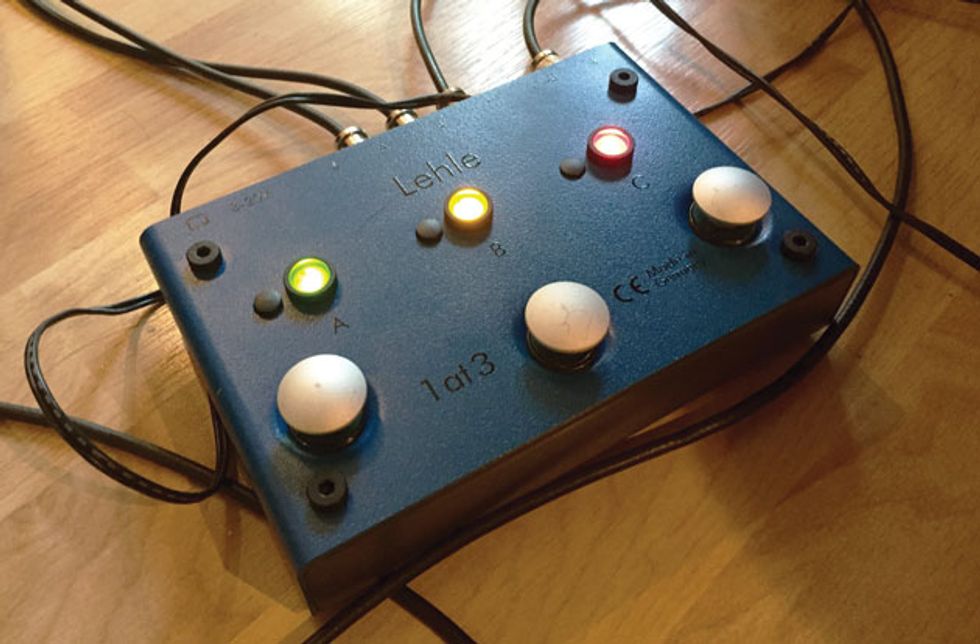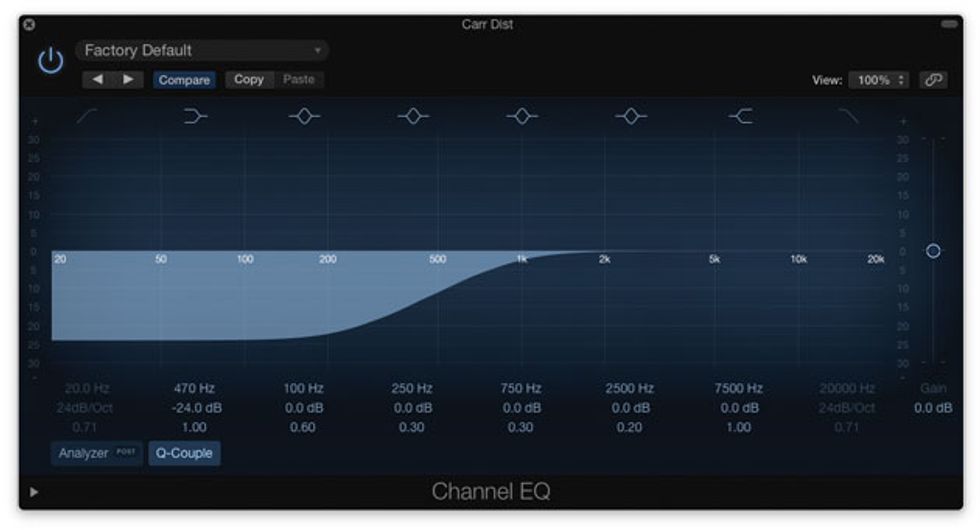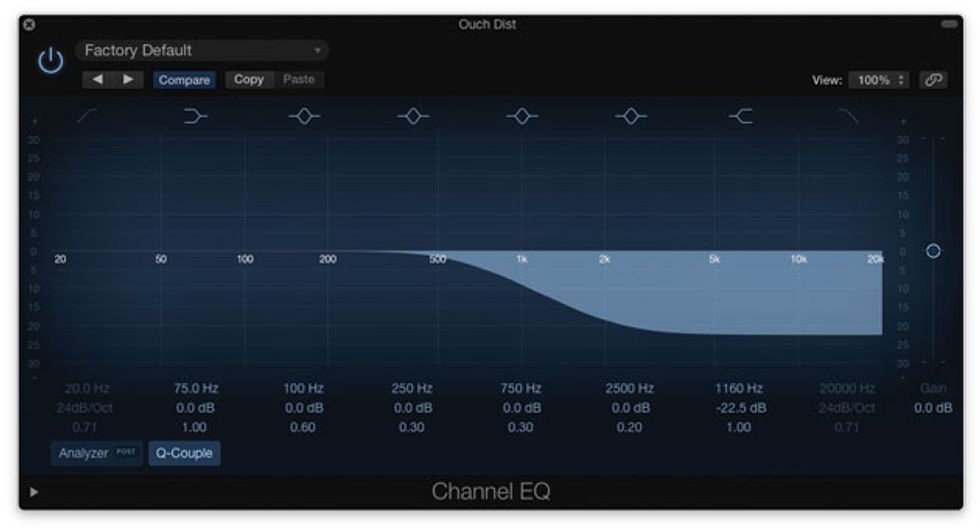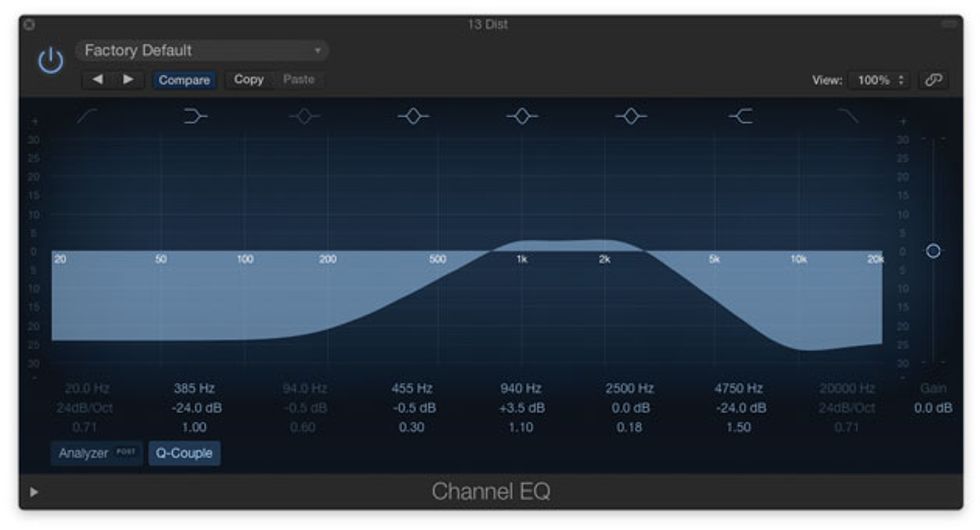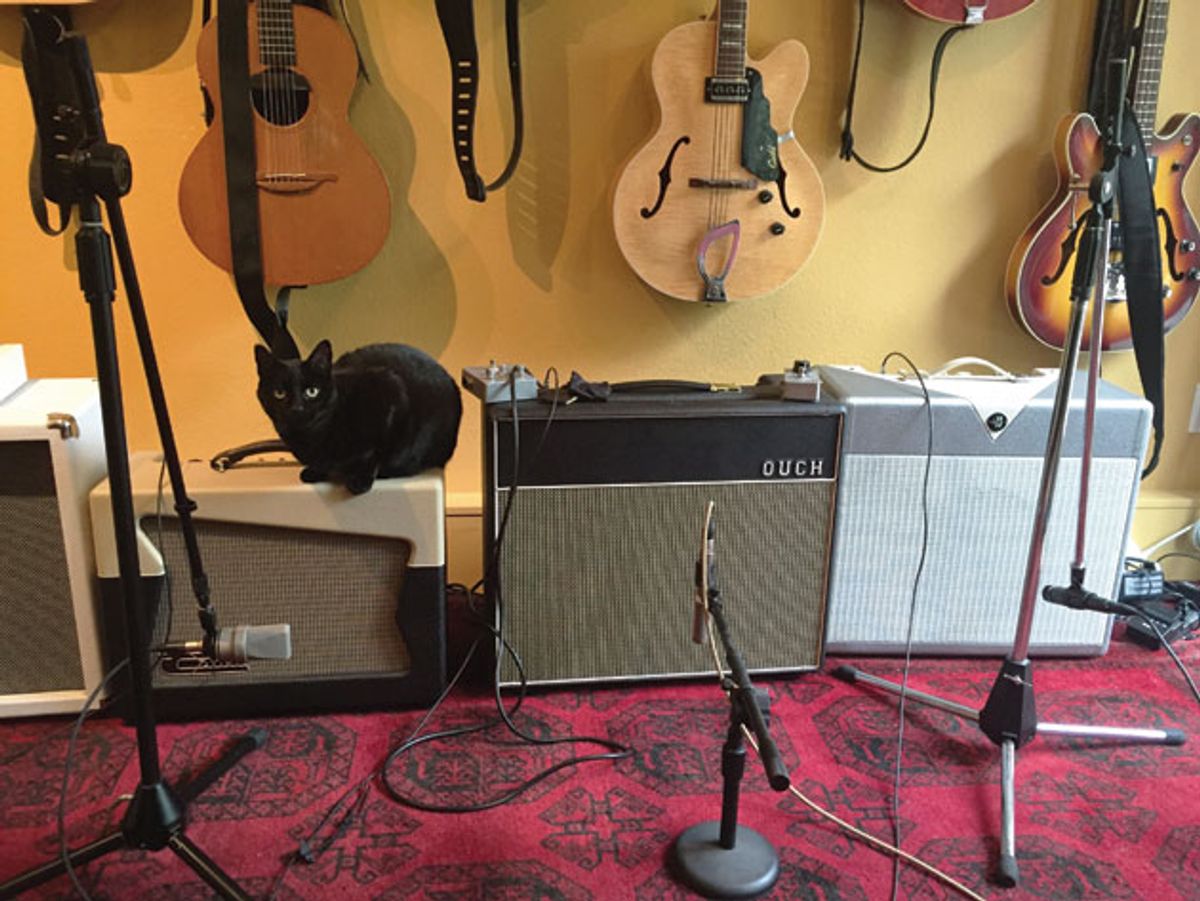
Blending amps for cool composite tones.
Are two amps (or three) better than one? Um … sometimes.
Recording guitarists often route their signal to multiple amps. Often it’s because we aren’t sure which will sound best until the production is complete. Sometimes it’s to obtain a blended tone not available from a single amp. (Famous example: Stevie Ray Vaughan, who often recorded many amps simultaneously—dozens, by some accounts—before assembling a composite tone at the mixing desk.)
This month we’ll look at various amp-blending techniques, from simply combining the natural sound of several amps to concocting complex “amp sandwiches” containing only particular frequencies from each amp.
Wall of amps. For these examples, I miked three amps: a shimmering Carr Skylark (a Fender blackface-inspired model), a blunt-nosed Marshall 18-watt clone, and a Divided by 13 CJ11, which has more of a Fender tweed flavor (Photo 1). I mixed mic types as well: There’s a Neumann TLM-103 condenser on the Carr, a Royer 121 ribbon on the Marshall clone, and a Shure SM-57 dynamic on the CJ11. (Perched atop the Carr, my cat is in for a nasty surprise when I plug in.)
Photo 2
There are various ways to route a guitar signal to several amps, from multiple reamp boxes to simply using the stereo outs of a chorus or delay stompbox. Here I used a Lehle 1 at 3, a buffered splitter box with switches for each of its three outputs (Photo 2).
Meet our lovely contestants. In Ex. 1 you hear each amp soloed in turn: Carr, Marshall clone, and CJ11.
I’ve miked the Carr dead center on the speaker cone for a bright sound. The Marshall clone is also miked at center, but with the mic a bit closer for maximum bass oomph (plus, ribbon mics tend to deliver fat lows by default). And don’t judge the lovely CJ11 by the tone heard here—just to try something new, I placed the SM-57 way off-axis—an experiment I probably won’t repeat. The resulting tone is distant and diffuse, without particularly strong highs or lows. But as you’ll hear, I found a way to incorporate even this stingy tone.
Spoiler alert, if you haven’t already guessed: We’re going to feature the Carr’s highs, the Marshall clone’s lows, and the CJ11’s mids. But first, lets hear how the three amps sound together without extreme EQ (Ex. 2).
The amps are panned wide. The Carr and its reverb are all the way left (because I love the ’60s-style sound of reverb on one channel only). The bass-heavy Marshall clone is center, and the CJ11 is fully right. It’s a spacious, high-impact sound, though perhaps a bit dense in the low mids. Ex. 3, by contrast, employs only the Carr and the Marshall clone, slightly panned. It’s got more percussive impact, at the cost of some midrange muscle. I could imagine either blend working, depending on the context.
Photo 3
Extreme EQ. Now let’s get our hands dirty. Ex. 4 returns to the two-amp sound of Ex. 3, but this time I used EQ plug-ins to remove all lows from the Carr (Photo 3) and all highs from the Marshall clone (Photo 4). You hear each amp soloed, and both sounds are pretty nasty. But combined, the massively EQ’d signals yield a compelling composite tone. The sound may be a bit on the woolly side, but it’s easy to adjust it by twiddling with the blend levels and EQ cutoff frequencies.
Photo 4
Photo 5
Now let’s go full sandwich, inserting midrange from the third amp between the bass and treble “bread.” Since the CJ11 sound as miked here is funky to begin with, I dialed in only a narrow EQ slice (Photo 5) for a retro-trashy transistor-radio tone. Ex. 5 solos the CJ11 briefly before the Carr and Marshall clone join in.
Which version is best? It depends on the context.
Clean meets mean. Just for contrast, let’s retrace our steps with a cleaner tone. Not entirely clean, though: As the soloed amps in Ex. 6 reveal, I’ve kept the Marshall clone a bit trashy in hopes that I can “distress” the clean sound without surrendering its clarity.
Same sequence as before: The three amps appear together without EQ in Ex. 7.
Ex. 8 is the Carr and Marshall clone only, with no EQ.
Ex. 9 removes the lows from the Carr and the highs from the Marshall clone. You hear each amp soloed, and then both together.
And finally, the deluxe amp sandwich in Ex. 10. As before, you hear the CJ11 first (stripped of both highs and lows), and then the three-amp blend.
But is it worth it? Say it with me, people: It depends on the context. (I envy my fellow PG columnists who have snappy tag lines. If I had one, that would be it. But sadly, “It depends on the context” lacks the simple power of Dirk’s “Keep on modding” or Pete’s “I wish you good tone.”)
The devil’s advocate thinks this technique is a waste of time. “A good guitar and a good amp are perfect on their own,” she says. “Besides, it’s usually a bad idea to put off musical decisions till the mix. Just choose a tone and commit to it, damn it!”
The devil’s advocate makes a strong case. But for better or worse, you’d never get these composite sounds from a single amp, and there are many classic examples of cool and distinctive tones wrung from multiple amps. So if you’re of an experimental bent, give this method a go!
Until next month … it depends on the context! (No, that totally doesn’t work.)
